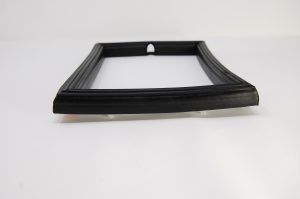Trim seal measurements let engineers choose the right rubber gaskets for sealing doors and hatches with radiused corners. There are three key measurements to consider.
- Bulb size
- Bend radius
- Trim thickness
Elasto Proxy, a rubber fabricator and distributor, can help you to determine the right trim seal measurements for your application. Many companies are familiar with Trim-Lok, but Elasto Proxy is your trim seal alternative if you need low-to-medium volume quantities. Our trim seal fabrication services also add value and we can help you with trim seal installation.
Request a quote from Elasto Proxy or keep reading to learn more about trim seal measurements.
Bulb Size
Trim seals, or bulb trim seals are they are also known, have a compressible rubber bulb that fills the gap and provides the sealing action. When the door or hatch is closed, the bulb compresses. When the door hatch is open, the bulb returns to original size.
Determining the bulb size that you need is a two-step process represented by this calculation.
Average Jam Dimension + Compression Percentage = Bulb Size
Average Jam Dimension
First, calculate the average jam dimension. Start by placing some modeling clay in each corner and then close the door or hatch to compress the clay. Then insert calipers into the clay and record the jam dimension, or gap size, for each corner. Now divide this number by four to determine the average.
Compression Percentage
Second, apply a compression percentage of 25% to 50% to the average jam dimension. Do not apply more than 50% because over-compressing the bulb can reduce seal life and cause compression set, a permanent deformation that occurs when a force that was applied to a material is removed.
Bend Radius
Trim seals are designed for radiused corners instead of 90° ones. Still, it’s important to choose a bend radius that will support flexing or bending and avoid kinking. To do this, determine the minimum distance from the center point to the edge (i.e., the radius) that the rubber gasket must bend.
Although a more flexible trim seal material can support a smaller bend radius, it’s important to remember that a radius that’s too tight can cause the corners of the trim seal to pop out. Conversely, a bend radius that is too large can cause the formation of recesses or valleys that allow the passage of water.
At our in-house laboratory, Elasto Proxy can perform tests to determine the minimum bend radius before kinking occurs. The results of these tests for trim seal measurements can help you to avoid problems such as drafty doors on mobile equipment or leaky doors on electronic enclosures. To learn more, contact us.
Trim Thickness
In addition to a compressible rubber bulb, trim seals have solid retainer, or trim section, that attaches to an edge or flange. When you make trim seal measurements, you’ll need to determine the thickness of the trim. This thickness, or gap, is simply the distance between the two straight sections (legs).
As a rule, trim thickness should equal flange thickness. For example, if a trim seal has a flange that is 1/2” thick, you need a trim thickness of 1/2”. If a trim seal has a flange that is 3/4”, choose a trim thickness of 3/4” instead. Choosing a trim seal with a larger or small gap than this may result in leakage.
Get Help with Trim Seal Measurements
Are you an engineer or an industrial buyer who needs low-to-medium volumes of trim seals? Elasto Proxy, a rubber fabricator and distributor, can help you to order products with the right trim seal measurements for bulb size, bend radius, and trim thickness. We can also help you with trim seal materials, colors, and standards.
To request a quote or get more information, let us know what you need.









